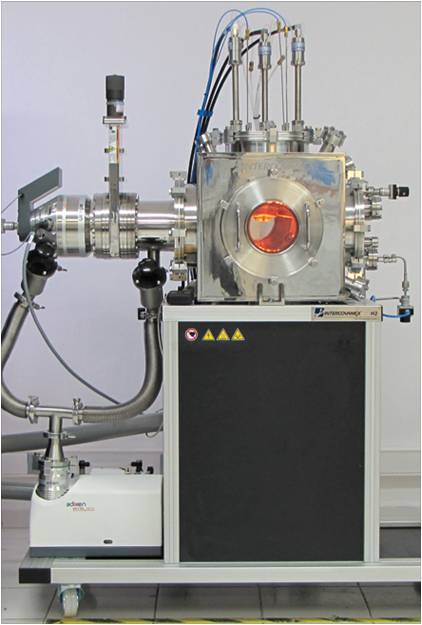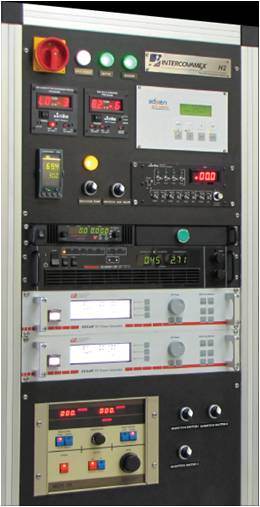Company Infos PVD-systems H2 High Vacuum Deposition System
Multi-technique and multi-geometrical system for PVD and CVD coatings
H2 UNIQUE FEATURES:
The Intercovamex H2 High Vacuum deposition system is well recognized as a suitable system for new materials and advanced coatings for R&D purposes due to its easy position change of accessories as well as its operational flexibility for different applications as nanotechnology, MEMS, hard coatings, transparent conductor coatings, photovoltaics and several semi-conductive materials. The H2 is optimized for PVD (Physical Vapor Deposition) for up to 6 materials by sputtering or evaporation (simultaneous or sequential) and is recommended for substrates of 100 mm diameter (125 mm max.) or 100 x 100 mm.
DEPOSITION CHAMBER:
The standard cubic stainless steel cross includes six 250 mm flanges (ISO
250 MF). The disassembling of these flanges is very fast and allows an easy
access into the chamber, the substrate or the deposition material. The six
system flanges are designed for: 1) mounting the sources of deposition,
2) positioning the substrate, 3) pumping connection and 4) viewport. Other
options are also available for: pulsed laser, ellipsometer, plasma analyzer,
gas analyzer, thickness monitor or controllers. Optional loading chamber
can also by installed (In this case CF 12" flanges are recomended instead
of ISO 250 MF). The H2 has fully compatible components to vacuum range of
10-8 Torr. The ultimate vacuum depends on pumping system selected and number
of options installed.
Several chambers can be connected together for assembling multi technique,
multi chamber system.

BAKE-OUT: The chamber can be baked up to 150° C with electric heating tapes. Optionally one or more UV lamps can be installed to accelerate the water desorption process and thus, reduce cycle time and improve ultimate vacuum and vacuum quality.
CHASIS AND CABINET: The H2 components are assembled on an aluminum chassis. The electrical and electronic components are integrated on a 1.70 m height cabinet. This flexible configuration allows user to choose the position of the cabinet relative to the chassis depending on laboratory space, user's comfort or specific needs.
LOADING CHAMBER:
This optional chamber allows the loading of substrates
while keeping the process chamber under high vacuum
conditions. It can be used also for substrates preparation before
deposition when options like an ion gun, resistive evaporator cell, or sample
heater are used. A standard loading chamber is evacuated by a 80 l/s turbo
pump, backed by a rotary vane pump of 5m3/h. Other pumping systems are available
as: higher capacity turbo, water trap or dry primary pump (oil free). A
glove box can be placed in front of the loading door to manipulate substrates
under controlled atmosphere.
PUMPING SYSTEM:
The most economical version includes a 255 l/s
turbomolecular pump baked by a rotary vane pump of 15 m3/h for an ultimate
vacuum of 10-6 Torr. To improve vacuum up to 10-7 Torr range operation a
400 l/s or 700 l/s turbomolecular are recommended. For a 10-8 Torr vacuum
range, a cryogenic pump is offered or a combination of turbo and other pumps.
In all cases, when a vacuum better than 10-6 Torr range, a loading chamber
is highly recommended. Dry pumping systems are also available. We offer
also turbo pump special versions for processes where big amount of oxygen
needs to be evacuated. Smaller ion pumps and cryogenic traps can be added
as well to improve vacuum quality.
SUBSTRATE HOLDER WITH OR WITHOUT HEATING:
Many options are offered according to budget, the
end-user application, and substrate sizes of 50, 75, 100 or 150 mm diameter.
Intercovamex offers also a very useful size among photovoltaic developers:
100 x 100 mm. Three temperature ranges are available for heating: 500°C,
700°C or 900°C. Some heater elements are compatible with a pressure
of 1 ATM and others with several mTorr of oxygen. Substrate biasing is also
available (optional). Intercovamex engineers will help you define the best
configuration adapted to your needs. Optionally a manual or electropneumatic
substrate shutter is offered as well as motorized rotation to improve thickness
homogeneity.
SPUTTERING:
Up to 6 magnetrons for 25mm diameter targets, 4
magnetrons for 25mm, 50mm or 75mm diameter targets or, 2 magnetrons for
100mm diameter targets can be mounted on the bottom flange (sputtering up
geometry). Each magnetron is equipped with an electro-pneumatic shutter
with rotary or flip type motion. Swing type motion is optional. Each magnetron
is installed on a bellow to optimize homogeneity of deposition and co-sputtering.
Each magnetron can generate a DC, pulsed DC or RF plasma. Maximum power
depends on the model of magnetron. For RF a low cost manual impe-dance matching
networked is offered. An automatic one is recommended for long-term and
unattended deposition. A re-circulating water chiller is necessary to cool
the magnetron's magnets, it is offered as an option if not available in
the laboratory.
PULSED LASER DEPOSITION:
Pulsated laser deposition is available with an
optional YAG or Eximer laser passing through a quartz window.
EVAPORATION:
The bottom flange can be equipped with up to 6
resistive evaporators or an electron gun with 1 to 6 crucibles. A configuration
with 5 Knudsen cells has proven to be very successful for CIGS photovoltaics.
Many Knudsen cells models are available according to the material to be
deposited.

ION GUN:
In this option, the ions produced can be accelerated toward the substrate
for cleaning purposes previously to deposition. They can also be used during
the deposition (ion beam assistance) resulting in better adhesion of deposited
layers.
GAS PLASMA CONTROL:
The standard gas introduction is done with a manual
needle valve. For better reproducibility or when a mixture gas is used,
1 to 8 Mass flow controllers are optionally available.
PROCESS PRESSURE CONTROL:
In the basic version, the end user controls the pressure by reading the
vacuum gauge and adjusting manually a gas introduction needle valve. For
unattended processes and highly reproducible results, an automatic downstream
pressure control system is offered. It consists of a motorized variable
conductance valve (installed between the turbo and the process chamber),
a high precision capacitance gauge and a controller. This latest will adjust
the valve opening to maintain precisely the process pressure selected by
the operator.
THICKNESS MONITORS AND CONTROLLERS:
Several options are available for measuring growth
rates and thickness deposited (monitor only) or to control deposition sources
according to these parameters (controller). The controller permits programming
of unattended multilayer's deposition. Up to 4 quartz balances con be mounted
inside the chamber (evaporation configuration). In sputtering configurations,
space available is usually much more restricted and only one movable quartz
balance is positioned in place of substrate to calibrate rates and then
removed during process. Each balance can be equipped with an individual
shutter. A re-circulating water chiller is recommended to cool each quartz
balance for reproducible measurements.
EXAMPLE OF SYSTEM CONFIGURATIONS:
For full specifications, please contact us webrequest@episerve.de
copyright EpiServe GmbH 2014, all rights reserved